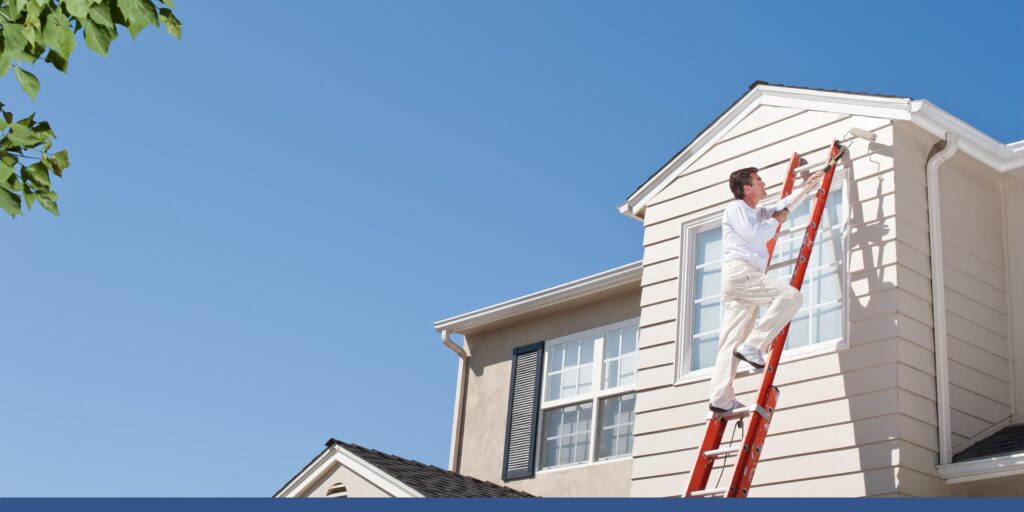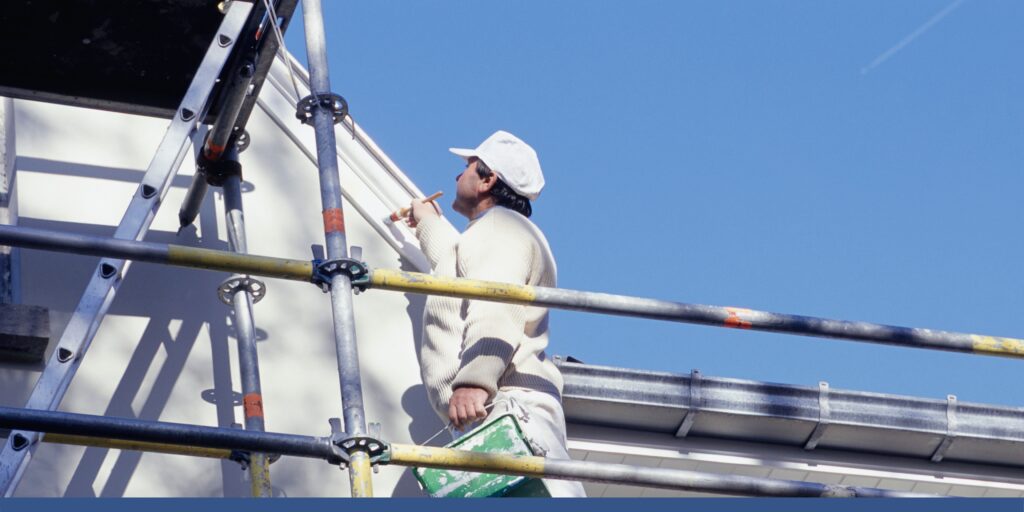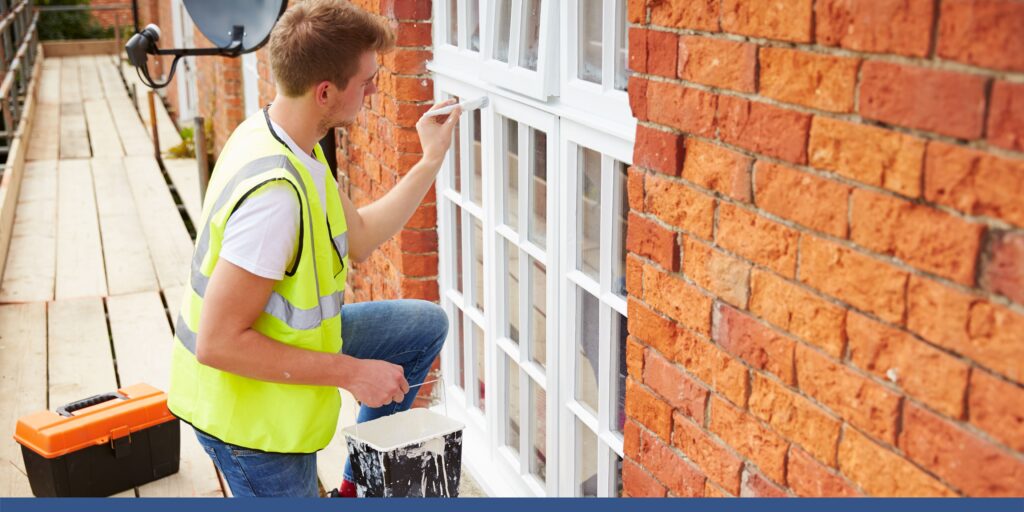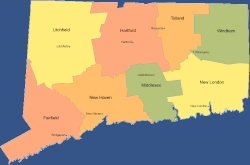As with any home remodeling and renovation project — timing is everything. Doing so will save you from costly repairs, time-consuming tasks, and other unnecessary stress while ensuring that your new paint job lasts as long as possible. Of course, there are no hard and fast rules for when to paint a house exterior or even whether to do it at all.
However, some factors may change, especially if you live in certain areas or specific states. For example, if you live in the northeastern parts of the country, the best time to paint a house exterior is in the spring. Temperatures are mild enough to allow you to paint, but not so hot that the paint dries too quickly.
To avoid being overwhelmed, it’s best to tackle this project in phases. Here’s a list of the factors that will determine the best time to paint a house exterior in Connecticut.

The Weather or Season
While painting your house exterior is not necessarily an urgent job, the best time of year to paint a house exterior is generally agreed upon as springtime. Before the hot summer months set in and sap your energy and enthusiasm, painting a house exterior in the spring allows you time to fix any potential problems, including structural issues that will require expensive repairs later on down the road. This season also allows you plenty of time for touch-ups and repairs if you find any issues after applying fresh paint!
Of course, painting during the summer can also be a good option. Connecticut has a semi-humid climate during this season so painting during this time allows you to get the job done quickly before autumn arrives.
If you have kids around, this season is also ideal if you want to enjoy indoor and outdoor home projects as they are primarily in schools giving you ample time to focus on your project.
However, remember that the sun is at its peak during summer, and as much as the heaty will help dry your newly painted surfaces, it can also cause damage and cracking, so make it a point to check in with the weather before picking up your paint brushes.
Fall is another great time to paint a house exterior. In Connecticut, the weather during this time is between the temperatures of spring and summer. This means conditions are comfortable but also not too hot or humid. However, the foliage of trees and shrubs might be denser during the autumn season, which could obstruct the view of your house and make it harder to spot imperfections in your paint job.
While winter can be a great time to repaint the inside of a house, it’s often not the best time to paint a house’s exterior. Connecticut usually has its harshest winters from December to around mid-March so the cold weather and high winds might not be ideal for painting. If you do decide to paint your house during these months, make sure you take extra precautions in preparing yourself and your project for the cold weather.
Can You Paint Your Own House Exterior?
When it’s cold outside, the paint is much more likely to freeze or crack due to the moisture in the air. Plus, if it’s too cold, you might also have to deal with an increased chance of rain which will only prolong and increase the cost of your home project. .
If you decide to paint a house during the winter, be sure to choose paints that can withstand lower temperatures. You might also want to hire a professional painter at Custom Colonial Painting to assist you better with the challenges of painting your house in the winter.
They cater to residents in the general Connecticut area so you can be sure they know what they’re dealing with!
The Condition of the Siding
The condition of the siding on your house will definitely impact how much it costs to paint it. For example, if you have a wood siding, it might be worth the extra cost to paint it instead of replacing it. However, if you have a vinyl siding, you might just want to replace your old siding rather than paint it.
As for the condition of your house and its foundation, this could impact how much painting a house costs as well. For example, if there are cracks in the foundation or other structural damage from the previous owner that needs repairing before you can paint, this could increase the cost of painting a house by $100 or more per square foot.
Your Budget
The final factor that impacts how much it costs to paint a house is your budget. This should include the costs of paint, materials, supplies, and any other expenses related to the job. For example, if you are only painting parts of the exterior of your house, it might be possible to paint by yourself. However, if you want to paint the entire exterior, it might be worth hiring a professional house painter Bethel CT to help you out. This way, you can save time and money and still have a quality finish on your home.
The best way to find out if you can paint the exterior of your house yourself is to call a local painting company and ask them for a free estimate. Then, compare the cost of their estimate to the cost of hiring a professional painter. If you can save money by doing it yourself, this is the best option.
Contact us at Custom Colonial Painting in Connecticut if you have any questions.

What Is the Best Time to Paint a House Interior?
The best time to paint the interior of your house is when the weather is warm, typically above 50 degrees Fahrenheit. This is also true for painting projects that you would like to do outdoors. This will help the paint dry faster and prevent condensation from forming on the walls. It also makes it easier for you to clean up after the job.
This time is also beneficial to your budget because prices are at their best, and materials needed for the project are easier to find. Of course, if you live in Connecticut where it gets extremely hot and humid during the summer, it might be worth hiring a professional painter to paint your house every year or two because of how much easier it is to clean up after they are done.
What Time of Year Is Best to Paint the Exterior of a House?
As mentioned above, the weather condition can make or break your home renovation project, no matter how big or small it is. If it’s too hot, you’ll want to wait until cooler months to start any painting task, regardless if it’s for interior or exterior. This will help the paint dry faster and prevent condensation from forming on the walls. If it’s cold, you’ll want to wait until warmer temperatures so that your house will not get damaged by frost or ice.
Also, you will want to remember that painting in the winter can be dangerous for your home as ice can form on your roof and in your gutters, blocking enough heat in your home to help dry your walls.
An additional factor is how long it has been since you painted your house. If it has been a while since the last time you painted and you have had some problems with fading or chipping, then now is a good time to do so again because there won’t be as much damage as there would have been had you waited too long after painting before doing this again.
You should also consider how much work needs to be done on your house before painting. For example, if there are large areas that need repair or if there are large holes in your roof or siding, then these should be taken care of first before scheduling an appointment with your contractors. These areas will need more attention than regular touch-ups do once they are done with their jobs.
How Often Should Houses Be Painted? (Interior and Exterior)
When it comes to painting houses, what matters most is how often the paint needs to be applied. This will depend on many different factors, such as the type of paint you are using, the climate in your area, and how long it has been since your last coat.
For example, if you live in places where humidity is high, such as Connecticut or the United Kingdom (UK), then your paint will need more time than if you live in an arid area. This is because humidity tends to increase the amount of time needed by an average coat of paint to dry before it can be applied again. This is how water usually reacts with the molecules in paint, causing them to stick together and not dry out as quickly as they would if there were no humidity present.
In addition, if you live in the northeastern area where there is a lot of sun or sun reflected off snow or ice for an extended period, then your house may need more coats than if your house was located somewhere that wasn’t as exposed to these elements. These conditions can cause fading and cracking problems, which will take longer for water-based paints to dry when applied again after being exposed to heat from these elements.
Tell-tale Signs Your House Needs Painting (What Happens if You Don’t)
Painting the interiors and exteriors of a home is beneficial for safety, aesthetics, and overall value. When you have a home that needs painting, you need to be on top of it. If you do not have time for this type of maintenance, you need to hire someone who does. When it comes to whether or not your house needs painting, it’s crucial not to overlook the small details that signal more significant problems looming just around the corner. Here are some things to spot before things get out of hand.

Your Walls Are More Beige Than White
Depending on how old your home is, you might want to consider painting the walls a different shade. As a home gets older, the chemicals used to create the initial color could leach out and create a beigey grey tone. In addition, exterior walls tend to be hotter than the interior of a home, which causes a higher level of sweating.
This sweat can cause discoloration on the paint’s surface, which makes it look beige. To prevent this from happening, simply use a product that has a sweat guard. This will protect the color from fading and allow the home to stay vibrant for much longer.
Your Ceiling Is More Brown Than Grey
If your ceiling looks more like a piece of old leather than a fresh grey finish, now might be the best time to paint it. Of course, you can paint ceilings just like any other wall, but consider using a roller to avoid uneven splatter marks.
In addition to painting the ceiling, you can also combat stains and other marks by using a mildew cleaner. Mildew is a common problem in bathrooms and kitchens where humidity is high. While you can tackle mildew with cleaning products, you can also paint over it.
You Can See Daylight Through Your Windows
If your windows require a tune-up, painting them is a great way to seal and protect them from harmful elements. Traditionally, windows are painted from the inside out. However, for maximum protection, you can apply a water-based sealer before applying your finish coat.
You should also consider adding a rubber gasket around the window frame to ensure that no moisture can get inside. If you’re going to paint your windows, wait until the end of autumn when temperatures are more relaxed. This will make the job easier, especially if you’re painting from the inside out.
There’s Drywall Dust Everywhere
If you’re building a room addition or demolishing walls, you’ll probably create a lot of drywall dust. If you’re not careful, that dust can end up all over the rest of your home, including your walls and other surfaces. Waiting until the air is cool and dry to clean up and using a HEPA vacuum to catch the dust can help you avoid dragging the dust all over the rest of your home.
If you want to avoid that dust staining your freshly painted walls, you can use a drop cloth or painter’s tape to cover the entrances to the room. You can then remove the tape and drop the cloth once you’ve finished cleaning up.

Peeling Walls and Damaged Paints
Peeling walls are a common problem that happens during the winter. In most cases, this happens because the walls are exposed to cold and dry air. However, if you live in a region where temperatures get below freezing, it’s best to wait until spring to paint.
Before painting, make sure that all surfaces are cleaned, including any vents and other openings that may be causing problems with the paint job. You can also use a unique coat of primer or sealant to protect your walls from damage.



